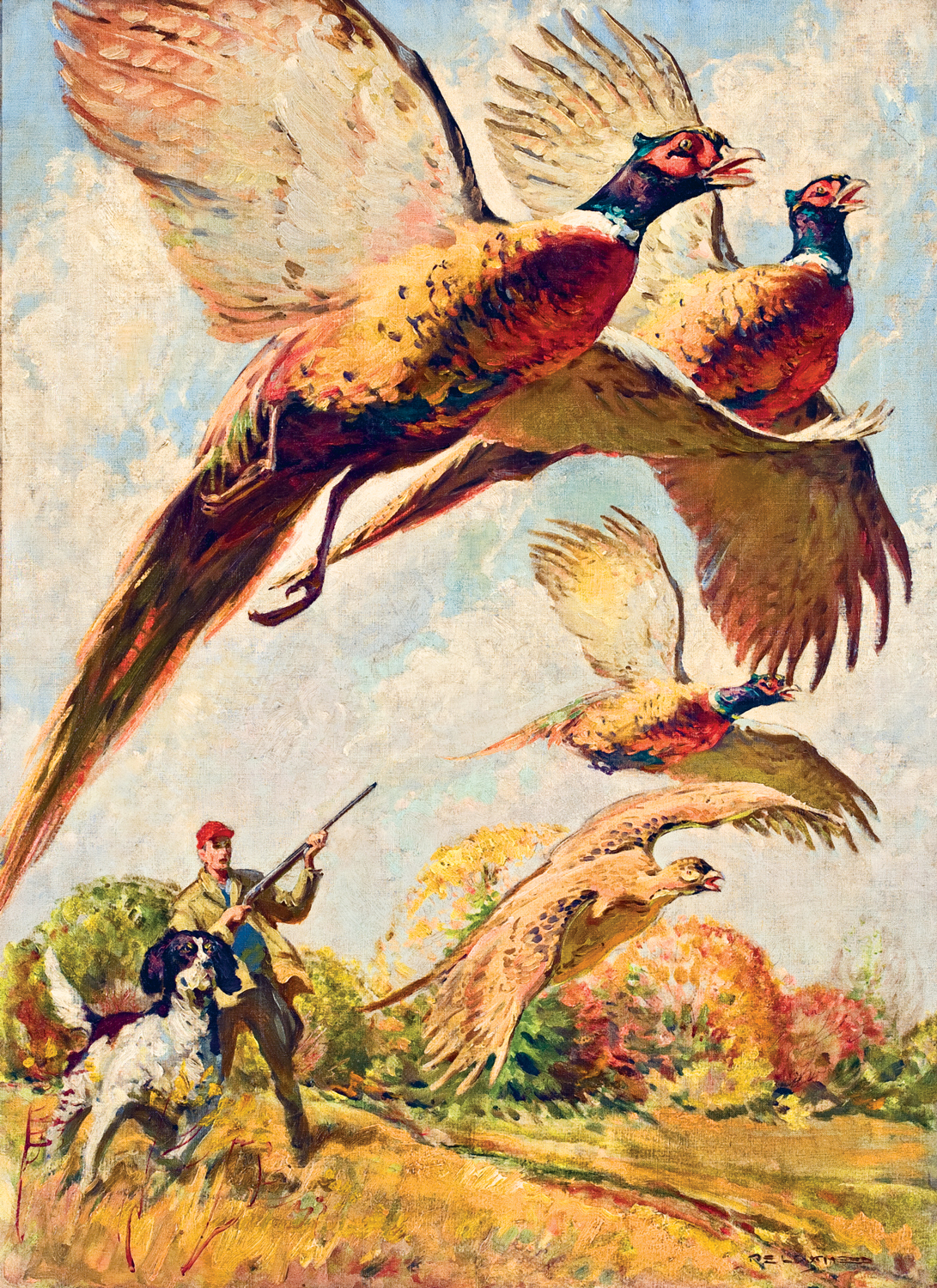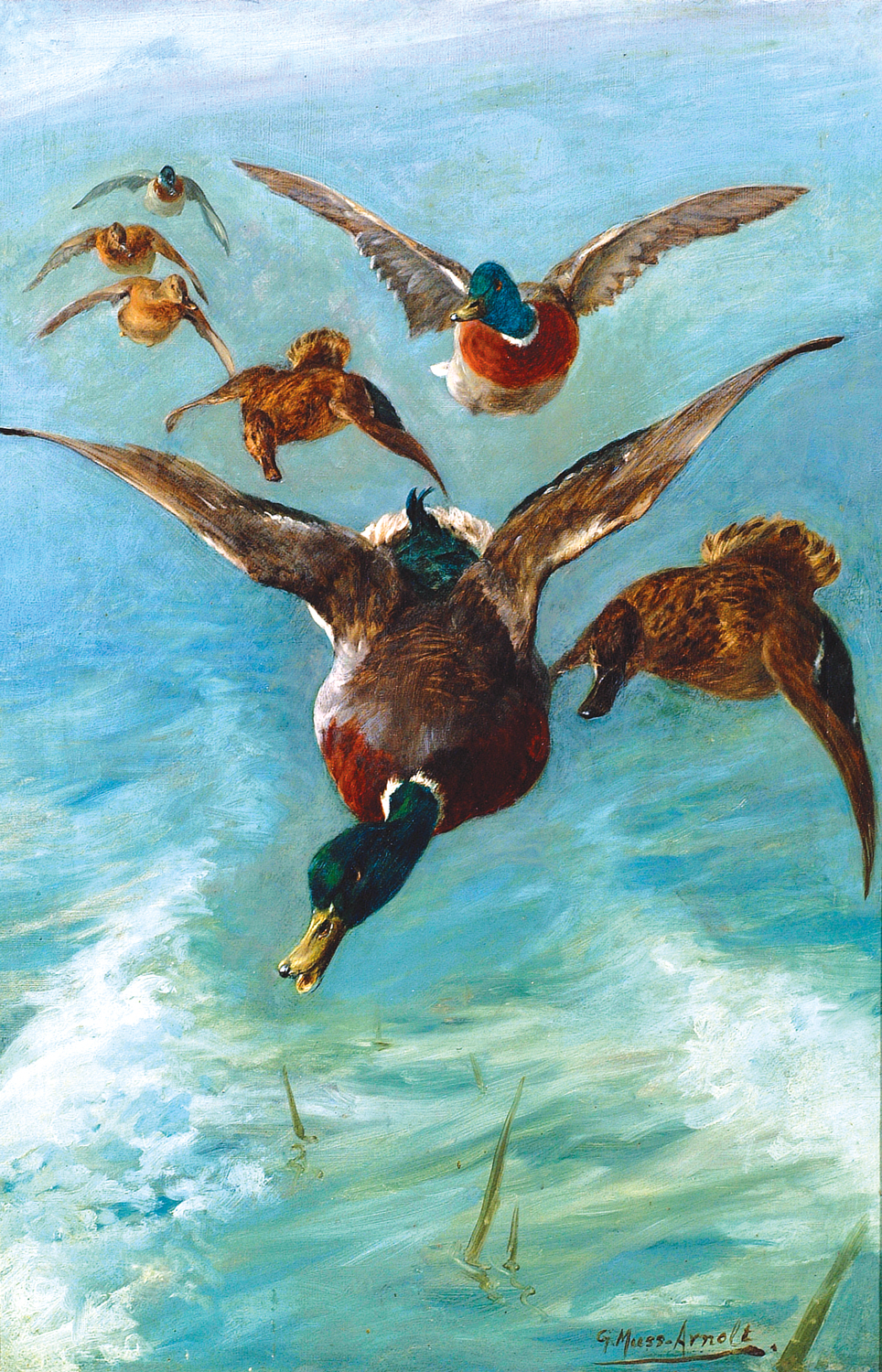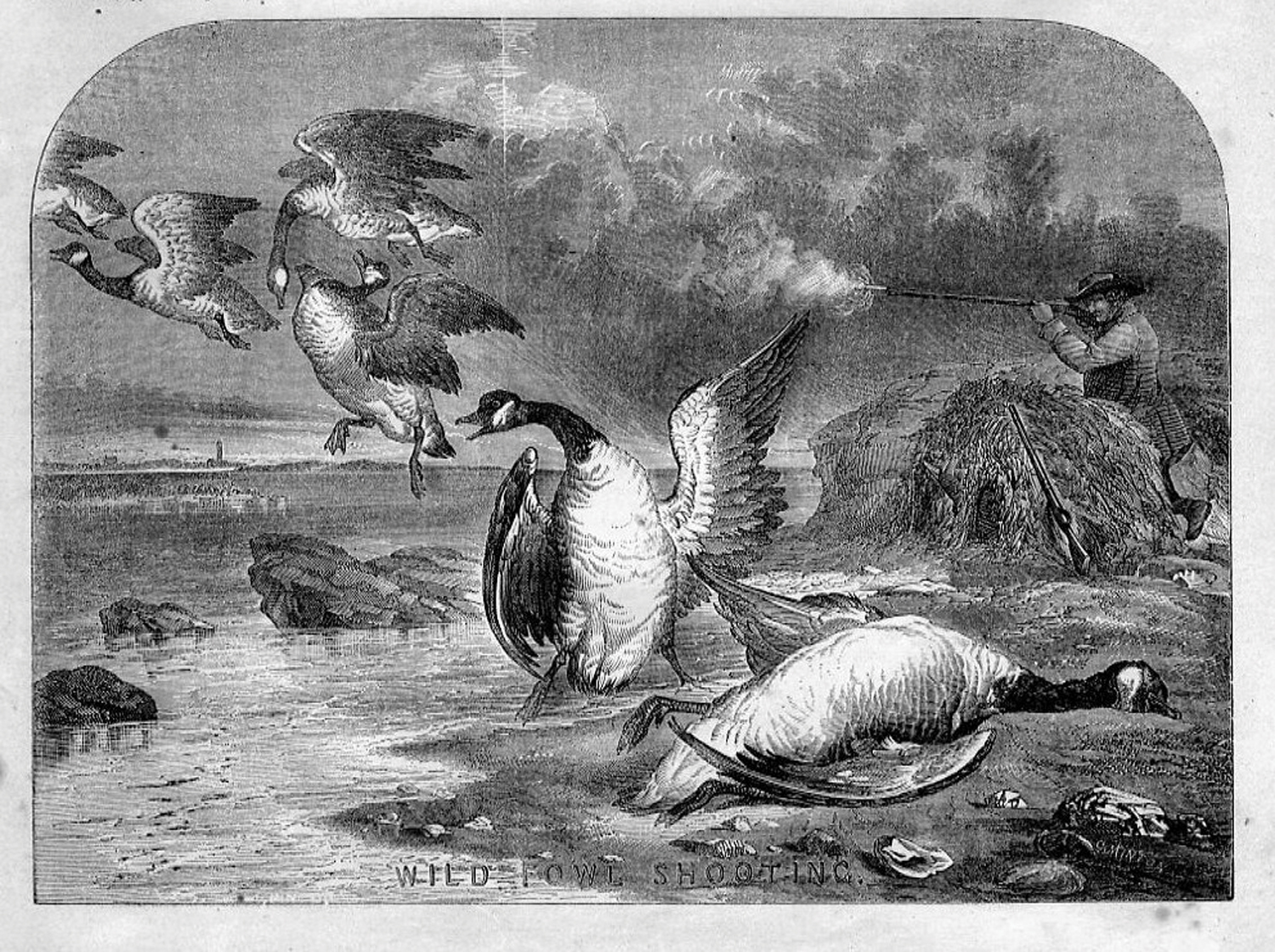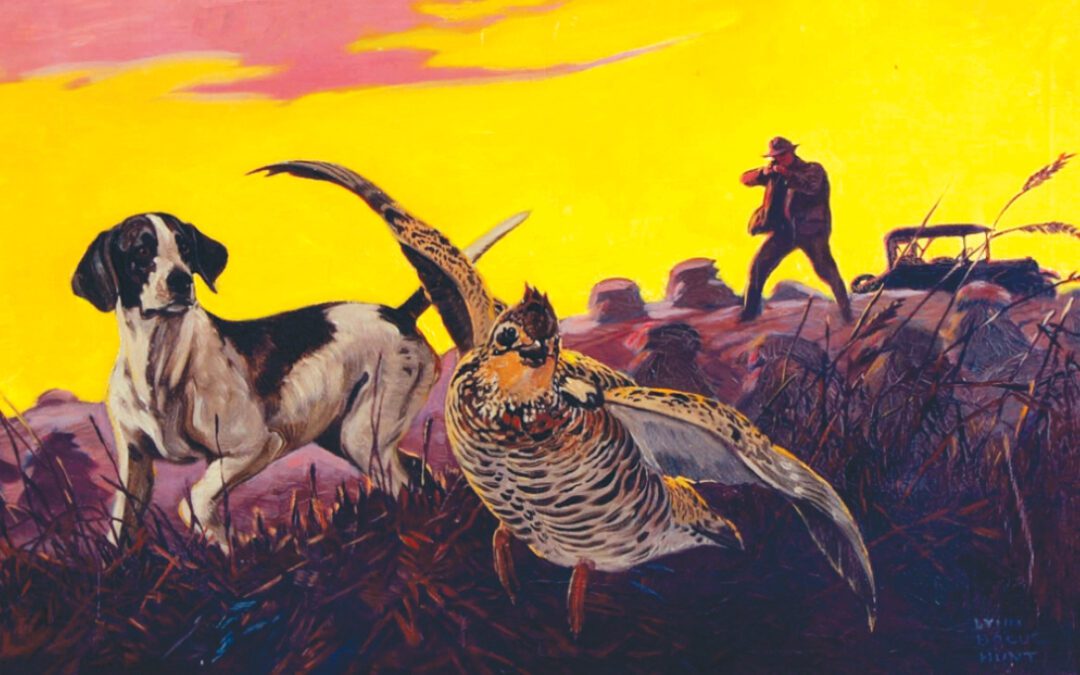There is a heavy norther blowing; the gulf is too rough to fish and there is no shooting now. When you are through work it is nearly dark and you can ride out on the boulevard by the sea and throw clay targets with a hand trap against this gale and they will dip and jump and rise into strange angles like a jacksnipe in the wind. Or you can throw them out with the gale behind them and they will go like a teal over the water. Or you can get down below the sea wall and have someone throw them out high over your head riding the wind, but if you puff one into black dust you cannot pretend it was an old cock pheasant unless you are a better pretender than I am. The trouble is there isn’t any thud, nor is there the line of bare trees, nor are you standing on a wet, leaf-strewn road, nor do you hear the beaters, nor the racket when a cock gets up and, as he tops the trees, you are on him, then ahead of him, and at the shot he turns over and there is that thump when he lands. Shooting driven pheasants is worth whatever you pay for it.
But when you cannot shoot you can remember shooting and I would rather stay home, now, this afternoon and write about it than go out and sail clay saucers in the wind, trying to break them and wishing they were what they’re not.

When you have been lucky in your life you find that just about the time the best of the books run out (and I would rather read again for the first time Anna Karenina, Far Away and Long Ago, Buddenbrooks, Wuthering Heights, Madame Bovary, War and Peace, A Sportsman’s Sketches, The Brothers Karamazov, Hail and Farewell, Huckleberry Finn, Winesburg, Ohio, La Reine Margot, La Maison Tellier, Le Rouge et le Noire, La Chartreuse de Parme, Dubliners, Yeat’s Autobiographies and a few others than have an assured income of a million dollars a year), you have a lot of damned fine things that you can remember. Then when the time is over in which you have done the things that you can now remember, and while you are doing other things, you find that you can read the books again and, always, there are a few, a very few, good new ones. Last year there was La Condition Humaine by André Malraux. It was translated, I do not know how well, as Man’s Fate, and sometimes it is as good as Stendhal and that is something no prose writer has been in France for over fifty years.
But this is supposed to be about shooting, not about books, although some of the best shooting I remember was in Tolstoi and I have often wondered how the snipe fly in Russia now and whether shooting pheasants is counter-revolutionary. When you have loved three things all your life, from the earliest you can remember: to fish, to shoot and later to read; and when, all your life, the necessity to write has been your master, you learn to remember more fishing and shooting and reading than anything else and that is a pleasure.
You can remember the first snipe you ever hit walking on the prairie with your father. How the jacksnipe rose with a jump and you hit him on the second swerve and had to wade out into a slough after him and brought him in wet, holding him by the bill, as proud as a bird dog, and you can remember all the snipe since in many places. You can remember the miracle it seemed when you hit your first pheasant when he roared up from under your feet to top a sweet briar thicket and fell with his wings pounding and you had to wait till after dark to bring him into town because they were protected, and you can feel the bulk of him still inside your shirt with his long tail up under your armpit, walking into town in the dark along the dirt road that is now North Avenue where the gypsy wagons used to camp when there was prairie out to the Des Plaines River where Wallace Evans had a game farm and the big woods ran along the river where the Indian mounds were.

I came by there five years ago and where I shot that pheasant there was a hotdog place and filling station and the north prairie, where we hunted snipe in the spring and skated on the sloughs when they froze in the winter, was all a subdivision of mean houses, and in the town, the house where I was born was gone and they had cut down the oak trees and built an apartment house close out against the street. So I was glad I went away from there as soon as I did. Because when you like to shoot and fish you have to move often and always farther out and it doesn’t make any difference what they do when you are gone.
The first covey of partridges I ever saw, they were ruffed grouse but we called them partridges up there, was with my father and an Indian named Simon Green and we came on them dusting and feeding in the sun beside the grist mill on Horton’s Creek in Michigan. They looked as big as turkeys to me and I was so excited with the whirr of the wings that I missed both shots I had, while my father, shooting an old lever action Winchester pump, killed five out of the covey and I can remember the Indian picking them up and laughing. He was an old fat Indian, a great admirer of my father, and when I look back at that shooting I am a great admirer of my father too. He was a beautiful shot, one of the fastest I have ever seen; but he was too nervous to be a great money shot.
Then I remember shooting quail with him when I do not think I could have been more than ten years old, and he was showing me off, having me shoot pigeons that were flying around a barn, and some way I broke the hammer spring in my single barrel 20 gauge and the only gun down there at my uncle’s place in Southern Illinois that no one was shooting was a big old L.C. Smith double that weighed, probably, nine pounds. I could not hit anything with it and it kicked me so it made my nose bleed. I was afraid to shoot it and I got awfully tired carrying it and my father had left me standing in a thickety patch of timber while he was working out the singles from a covey we had scattered. There was a red bird up in a tree and then I looked down and under the tree was a quail, freshly dead. I picked it up and it was still warm. My father had evidently hit it when the covey went up with a stray pellet and it had flown this far and dropped. I looked around to see nobody was in sight and then, laying the quail down by my feet, shut both my eyes and pulled the trigger on that old double barrel. It kicked me against the tree and when I opened it up I found it had doubled and fired both barrels at once and my ears were ringing and my nose was bleeding. But I picked the quail up, reloaded the gun, wiped my nose and set out to find my father. I was sick of not hitting any.
“Did you get one, Ernie?”
I held it up.
“It’s a cock,” he said. “See his white throat? It’s a beauty.”
But I had a lump in my stomach that felt like a baseball from lying to him and that night I remember crying with my head under the patchwork quilt after he was asleep because I had lied to him. If he would have waked up I would have told him, I think. But he was tired and sleeping heavily. I never told him.
So I won’t think any more about that but I remember now how I broke the spring in the 20 gauge. It was from snapping the hammer on an empty chamber practicing swinging on the pigeons after they wouldn’t let me shoot any more. And some older boys came along the road when I was carrying the pigeons from the barn to the house and one of them said I didn’t shoot those pigeons. I called him a liar and the smaller of the two whipped hell out of me. That was an unlucky trip.

On a day as cold as this you can remember duck shooting in the blind, hearing their wings go whichy-chu-chu-chu in the dark before daylight. That is the first thing I remember of ducks; the whistly, silk tearing sound the fast wingbeats make; just as what you remember first of geese is how slow they seem to go when they are traveling, and yet they are moving so fast that the first one you ever killed was two behind the one you shot at, and all that night you kept waking up and remembering how he folded up and fell. While the woodcock is an easy bird to hit, with a soft flight like an owl, and if you do miss him he will probably pitch down and give you another shot. But what a bird to eat flambé with armagnac cooked in his own juice and butter, a little mustard added to make a sauce, with two strips of bacon and pommes soufflé and Corton, Pommard, Beaune or Chambertin to drink.
Now it is colder still and we found ptarmigan in the rocks on a high plain above and to the left of the glacier by the Madelener-haus in the Vorarlberg with it blowing a blizzard and the next day we followed a fox track all day on skis and saw where he had caught a ptarmigan underneath the snow. We never saw the fox.
There were chamois up in that country too and blackcock in the woods below the timberline and big hares that you found sometimes at night when we were coming home along the road. We ate them jugged and drank Tyroler wine. And why, today, remember misses?
There were lots of partridges outside of Constantinople and we used to have them roasted and start the meal with a bowl of caviar, the kind you never will be able to afford again, pale grey, the grains as big as buckshot and a little vodka with it, and then the partridges, not overdone, so that when you cut them there was the juice, drinking Caucasus burgundy, and serving French fried potatoes with them and then a salad with roquefort dressing and another bottle of what was the number of that wine? They all had numbers. Sixty-one, I think it was.
And did you ever see the quick, smooth-lifting, reaching flight the lesser bustard has, or make a double on them, right and left, or shoot at flighting sand grouse coming to water early in the morning and see the great variety of shots they give and hear the cackling sound they make when flighting, a little like the noise of prairie chickens on the plains when they go off, fast beat of wings and soar, fast beat of wings and soar stiff-winged, and see a coyote watching you a long way out of range and see an antelope turn and stare and lift his head when he hears the shotgun thud? Sand grouse, of course, fly nothing like a prairie chicken. They have a cutting, swooping flight like pigeons but they make that grouse-like cackle, and with the lesser bustard and the teal, there is no bird to beat them for the pan, the griddle or the oven.
So you recall a curlew that came in along the beach one time in a storm when you were shooting plover, and jumping teal along a water-course that cut a plain on a different continent, and having a hyena come out of the grass when you were trying to stalk up on a pool and see him turn and look at ten yards and let him have it with the shotgun in his ugly face, and standing, to your waist in water, whistling a flock of golden plover back, and then, back in the winter woods, shooting ruffed grouse along a trout stream where only an otter fished now, and all the places and the different flights of birds, jumping three mallards now, down where the beavers cut away the cottonwoods, and seeing the drake tower, white-breasted, green-headed, climbing and get above him and splash him in the old Clark’s Fork, walking along the bank watching him until he floated onto a pebbly bar.
Then there are sage hens, wild as hawks that time, the biggest grouse of all, getting up out of range, and out of range, until you came around an alfalfa stack and four whirred up one after the other at your feet almost and, later walking home in your hunting coat they seemed to weigh a ton.
I think they all were made to shoot because if they were not why did they give them that whirr of wings that moves you suddenly more than any love of country? Why did they make them all so good to eat and why did they make the ones with silent flight like woodcock, snipe and lesser bustard, better eating even than the rest?
Why does the curlew have that voice, and who thought up the plover’s call, which takes the place of noise of wings, to give us that catharsis wingshooting has given to men since they stopped flying hawks and took to fowling pieces? I think that they were made to shoot and some of us were made to shoot them and if that is not so well, never say we did not tell you that we liked it.
Editor’s Note: Copyright © 1935 by Ernest Hemingway. Copyright renewed © 1963 by Mary Hemingway. Copyright © 1967 by Mary Hemingway. Reprinted by permission of Scribner/Touchstone, imprints of Simon & Schuster, Inc.

